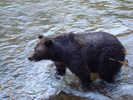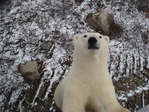

Storm Crow survival has a particular interest in bears with a long-term aim of seeing and photographing all the surviving species in the wild. We aim to have articles on all the species and have already seen and photographed all species in captivity. Eventually we aim to add articles and photos on many of the sub species.
 Bears are an iconic carnivore (Family Ursidae), they are caniforms or doglike carnivores with stocky bodies, relatively small ears, short tails and five clawed paws with non-retractable claws, they are good climbers and often good swimmers. They are generally omnivores with the Polar bear being mainly a carnivore and the giant Panda being mainly vegetarian (although contrary to popular belief not entirely).
Bears are an iconic carnivore (Family Ursidae), they are caniforms or doglike carnivores with stocky bodies, relatively small ears, short tails and five clawed paws with non-retractable claws, they are good climbers and often good swimmers. They are generally omnivores with the Polar bear being mainly a carnivore and the giant Panda being mainly vegetarian (although contrary to popular belief not entirely).
Polar bears are the largest land carnivores and have been recorded as weighing in at 700Kg and an overall length of nearly 10ft. All species have males much larger and heavier than females with the difference being more marked among the smaller species. Heavier built than predatory big cats, bears rely on strength rather than speed and have a heavy gait due to a big powerful build with large shoulder blades and pelvis. They are able to stand up on their back legs with good balance, they generally have poor eyesight (although unlike other carnivores they do see in colour) and fairly poor hearing and uniquely among mammal carnivores do not have whiskers on their snout but they have the best sense of smell of any carnivore even dogs. Teeth vary depending on species and the balance of meat to vegetation which forms their diet. Bears generally have few if any predators except for humans.
 Bears are iconic animals and feature in the myths of many cultures as a symbol of strength and ferocity having been part of human history being hunted for fur and meat since prehistory (there is some evidence of prehistoric bear worship in some areas of Europe and Asia) and used in traditional medicines and sympathetic magic as well as being exploited for entertainment. Some animals have been tamed but have never been domesticated. Sadly this has lead to extinction in many areas (combined with loss of habitat) and cruel exploitation which continues in many areas placing them under threat.
Bears are iconic animals and feature in the myths of many cultures as a symbol of strength and ferocity having been part of human history being hunted for fur and meat since prehistory (there is some evidence of prehistoric bear worship in some areas of Europe and Asia) and used in traditional medicines and sympathetic magic as well as being exploited for entertainment. Some animals have been tamed but have never been domesticated. Sadly this has lead to extinction in many areas (combined with loss of habitat) and cruel exploitation which continues in many areas placing them under threat.
8 species are still in existence, all other forms are sub species or variants of these 8 species. They are a successful family having adapted to most environments with forms inhabiting Europe, Asia, North and South American continents although 6 of the 8 species are now endangered. Some other animals are often mistakenly thought of as bears, such as Red Panda but they are not actually part of the bear family.
The 8 species in order of size are.
Polar bear (Sea Bear) Ursus Maritimus)
Brown Bear (Grizzly Bear) Ursus Arctos)
American Black Bear (Ursus Americanus)
Moon Bear (Asian Black bear), Ursus Thibetanus)
Spectacled bear (Andean Bear)
Sloth Bear (Melursus ursinus)
Giant Panda (Ailuropoda melanoleuca)